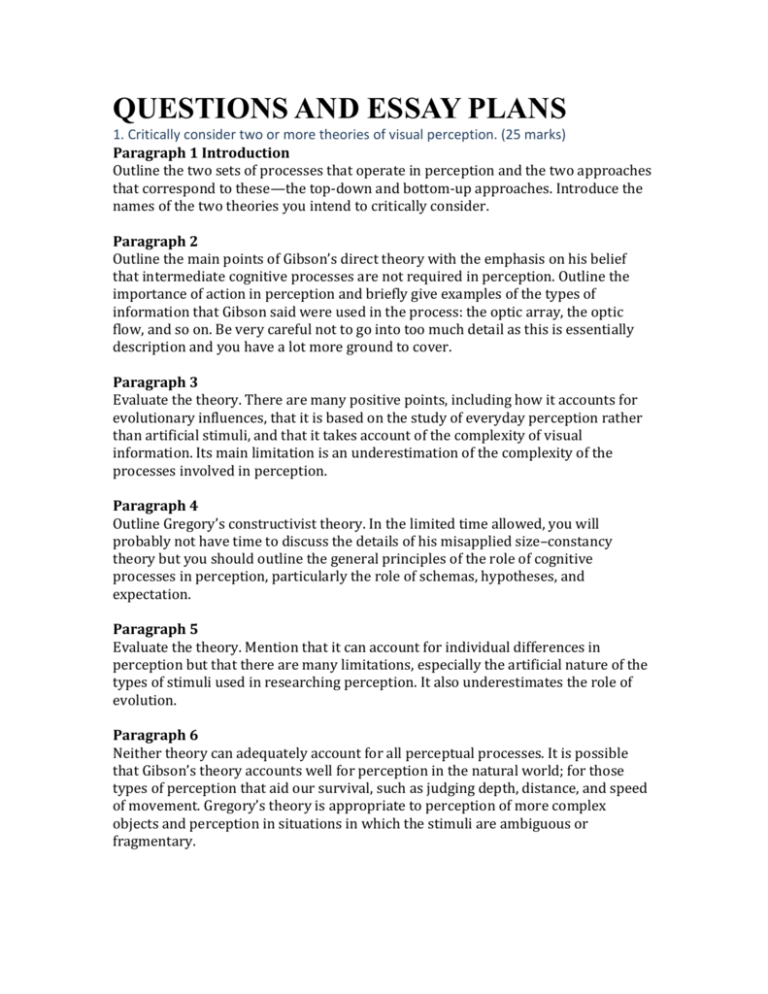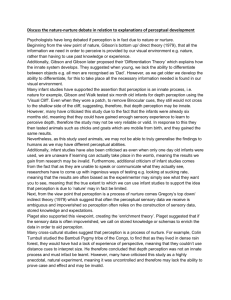questions and essay plans
advertisement

QUESTIONS AND ESSAY PLANS 1. Critically consider two or more theories of visual perception. (25 marks) Paragraph 1 Introduction Outline the two sets of processes that operate in perception and the two approaches that correspond to these—the top-down and bottom-up approaches. Introduce the names of the two theories you intend to critically consider. Paragraph 2 Outline the main points of Gibson’s direct theory with the emphasis on his belief that intermediate cognitive processes are not required in perception. Outline the importance of action in perception and briefly give examples of the types of information that Gibson said were used in the process: the optic array, the optic flow, and so on. Be very careful not to go into too much detail as this is essentially description and you have a lot more ground to cover. Paragraph 3 Evaluate the theory. There are many positive points, including how it accounts for evolutionary influences, that it is based on the study of everyday perception rather than artificial stimuli, and that it takes account of the complexity of visual information. Its main limitation is an underestimation of the complexity of the processes involved in perception. Paragraph 4 Outline Gregory’s constructivist theory. In the limited time allowed, you will probably not have time to discuss the details of his misapplied size–constancy theory but you should outline the general principles of the role of cognitive processes in perception, particularly the role of schemas, hypotheses, and expectation. Paragraph 5 Evaluate the theory. Mention that it can account for individual differences in perception but that there are many limitations, especially the artificial nature of the types of stimuli used in researching perception. It also underestimates the role of evolution. Paragraph 6 Neither theory can adequately account for all perceptual processes. It is possible that Gibson’s theory accounts well for perception in the natural world; for those types of perception that aid our survival, such as judging depth, distance, and speed of movement. Gregory’s theory is appropriate to perception of more complex objects and perception in situations in which the stimuli are ambiguous or fragmentary. 2(a). Describe and evaluate one study of the development of perceptual abilities. (10 marks) This part of the question requires a high level of selectivity as you need to choose a study that will provide enough AO1 and AO2 content for 10 marks. Paragraph 1 Introduction Describe the “visual cliff” research on depth perception by Gibson and Walk (1960): The “visual cliff” was a glass-top table underneath which a check-patterned cloth was positioned. A “shallow” side was created by positioning the cloth close to the glass under one half of the table, and positioning the cloth further away on the other half created a “deep” side. Infants between the ages of 6½ and 12 months were tested for depth perception by placing them on the shallow side and seeing if they could be tempted to cross to the deep side. Most infants could not be tempted by their favourite toy or by their mother’s voice, which suggests that depth perception had developed, as the babies were reluctant to cross to the “deep” side. Paragraph 2 Explain that this is not evidence that depth perception is necessarily innate, as babies tested at 7 months may have learned depth perception cues. Arterberry, Yonas, and Bensen’s (1989) study provides evidence for this. Infants of 7 months reached for the “closer” of two objects, whereas 5-month-olds did not. However, research on retinal image size in infants younger than 2 weeks old does provide evidence of innate perceptual abilities. Two different size objects had the same retinal size due to being different distances away from the infant, yet the infants were more distressed by the objects that came closest to them, which shows that they were able to perceive depth from a very young age (Bower, Broughton, & Moore, 1970). Paragraph 3 Evaluate the weaknesses of the visual cliff. For example, as a measure it is limited because the method shows that the deep side disturbs infants but this does not reveal how they perceive depth. Consider the implications of this in terms of internal validity and why it is difficult to investigate cognitive processes. Then consider external validity by discussing mundane realism and ecological validity. 2(b). Discuss the role of nature–nurture in relation to perceptual development. (15 marks) With this part of the question the research evidence needs to be used effectively so make sure you use link phrases. Paragraph 1 Introduction Provide evidence for the role of nature in perceptual development, i.e. the perceptual abilities that seem to be present at birth or very shortly thereafter, e.g. aspects of face perception; aspects of size and shape constancy; dominance of global over local features seem to be present at birth. This suggests these are innate visual capacities or very rapid learning. Also consider maturation as evidence for. Explain how this means the abilities are genetically predisposed but require a certain amount of physical development before they are realised, e.g. visual acuity; colour vision, and binocular disparity develop within a critical or sensitive period and so this suggests the involvement of genetic factors and so nature. Paragraph 2 Explain how other aspects of visual perception take months to develop, e.g. depth perception, and so this suggests the role of learning (nurture). The significant crosscultural differences also support the role of learning as they suggest that experience (i.e. learning) of the environment shapes perceptual development. Consider how distortion and readjustment studies also support the role of learning in visual development. You can also use cross-cultural research to support the claim that perceptual development is based on learned experience. Paragraph 3 Consider the threats to validity that limit the research evidence. For example it is difficult to interpret the adult readjustment studies, and the distortion study is also difficult to interpret because it can be used as evidence for nature and nurture. Consider the evolutionary basis of cultural differences in perceptual abilities. This sounds strange as of course evolution predicts universal behaviour but it also favours those who can adapt to the environment. Discuss the reductionism of taking either the nature or nurture approach and consider how they must interact. For example, even abilities that are mainly innate, such as perception, require learning in order to understand what has been perceived in the environment. 3. Outline and evaluate Bruce and Young’s theory of face recognition. (25 marks) Paragraph 1 Introduction Summarise the eight components of face recognition identified by Bruce and Young (1986). Paragraph 2 Outline how Bruce and Young (1986) suggest different processes are involved in recognition of familiar and unfamiliar faces: the processing of facial identity (who is the person?) and the processing of facial expression; also that the processes involved in facial speech analysis (using lip movement to facilitate speech perception) differ from those used in other aspects of face processing. Outline their assumption that the face should be recognised before other information about the individual is accessed. Paragraph 3 Use Humphrey, Avidan, and Behrmann (2007) as evidence of separate routes in the processing of facial identify and facial expression. Similarly, use Campbell, Landis, and Regard (1986) as evidence of different processes involved in facial speech analysis and face recognition. Paragraph 4 Use Kampf, Nachson, and Babkoff (2002) as evidence for the prediction that face recognition preceded occupation identification, which preceded naming of the stimulus. Also use Young, Hay, and Ellis (1985) as further evidence that we cannot put a name to a face without also having available other information about that person (e.g. his/her occupation). Use Brédart et al. (2005) as evidence against and then offer an explanation for the contradiction, which may be the amount of exposure we experience of colleagues’ names. Paragraph 5 Evaluate the positives of the theory. It has improved our understanding and there is much empirical support. Paragraph 6 Discuss the negatives: case studies have limited generalisability; the processes are unlikely to be completely separate. The fact the great majority of prosopagnosics have severe problems with processing facial expression as well as facial identity suggests that the two processing routes are only partially separate. Also, the theory is too inflexible in the assumption that the processing of names always occurs after the processing of other personal information about faces.







